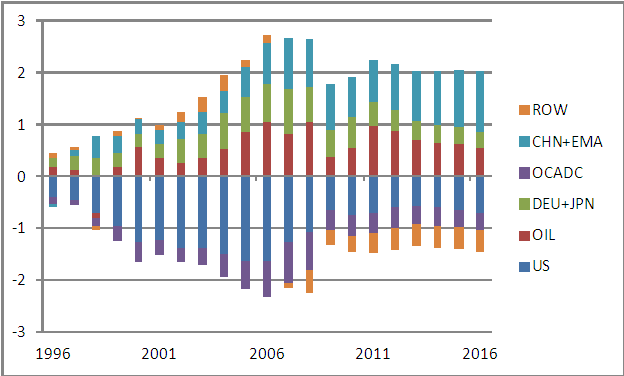Last week I had the opportunity to attend an IMF conference (organized by Olivier Blanchard, Krishna Srinivasan, and Hamid Faruqee) focusing on the critical issue of assessing the sources of the pre-crisis imbalances in systemically key countries. The proceedings also had a forward looking component, highlighting the difficulties of determining when external imbalances are problematic. The conference proceedings are here.
To place the topic in perspective, here is the graph of current account imbalances, from the September 2011 World Economic Outlook:

Figure 1: Current account balances, as a share of world GDP. Forecasts from 2011 onward. Source: IMF WEO (Sept. 2011).
Here is the conference agenda, with links to the presentations. More links are available at the IMF conference website.
Introductory and Welcoming Remarks
• Olivier Blanchard
• G-20 MAP Focus on Imbalances—Krishna Srinivasan
• G-20 MAP Indicative Guidelines: how/why 7 countries were chosen for deeper assessment of imbalances—Emil StavrevSession 1: What can explain large current account surpluses?
Moderator: Ashoka ModyCase studies of China and Germany—presentations by Shaun Roache and Vladimir Klyuev
Discussants:
• Nicholas Lardy [Presentation
]
• Joshua Aizenman [Presentation
]Case studies of Japan—presentation by Josh Felman
Discussant:
• Joseph Gagnon [Presentation
]Session 2: What can explain large current account deficits?
Moderator: Krishna SrinivasanCase studies of United Kingdom and United States—presentations by Shaun Roache and Vladimir Klyuev
Discussants:
• Jay Shambaugh [Presentation
]
• Stephen PickfordCase study of France and India—presentations by Joong Shik Kang and Josh Felman
Discussant:
• Arvind SubramanianLuncheon and Talk (HQ 2 Conference Hall 2)—By Invitation Only
John Lipsky—reflections on G-20 process, imbalancesSession 3: External Balance Assessments
Moderator: Jonathan D. OstryPresentation by Steve Phillips [Presentation
]
Discussants:
• Menzie Chinn [Presentation
]
• Joshua Aizenmann [Presentation
]Roundtable—Imbalances and the Global Economy: Past, Present, and Future
Moderator: Nemat Shafik (IMF, Deputy Managing Director)
Panelists:
Olivier Blanchard, IMF, Economic Counsellor and Director
Maurice Obstfeld, University of California at Berkeley, Professor Presentation
Stephen Pickford, HM Treasury, Managing Director—retired; Associate Fellow, Chatham House
Paul Rochon, Canada, Associate Deputy Minister of Finance
Christian Broda, Duquesne Capital, Managing Director Presentation
Some of my thoughts on global imbalances here: [1] [2] [3]. And some assessment of the “blame it on Beijing” approach to explaining the financial crisis of 2008: [4] [5].
OT: Highlights from just-released Feb. STEO:
January US oil consumption fell 4.6% compared to Jan. a year ago. That’s a spectacular fall. This is partly offset by a comparatively warm winter, with diesel fuel off 18%. Notwithstanding, gasoline consumption was also down 3.6% compared to a year ago.
January oil consumption was the third lowest since March 1997. (The lower months were Sept. 2008 and May 2009. May 2009, a virtual tie with Jan. 2012, was the trough of the recession. Lehman collapsed in Sept. 2008.)
I would note that only twice have we seen such a drop in oil consumption without a recession: in 1981-1982 in a period bracketed by two recessions; and from Q3 2011 to the present.
Titles and contents fit well to gather,they only need a moral ending.The ariadne thread is traceable,starting from the CA/ GDP fitted and unfitted where Germany is an outlier as of year 2000.The exchange rate is not the culprit since the reactivity is exponential and too fast.The foreign exchange rates is coming late as a resource of last resort.What has happened for such a huge variance to be ?The year 2000 is a saddle point as always,the cold fusion has been reached and nurtured well afterwards.
P17 (External balance assessment Steve Phillips).
M.Chinn confirms no normative pattern on foreign exchange to be detected with a sample of 45 countries on a time frame of 26 years,but many dummies required. In a larger spectrum the “margaritas ante porcos” feeding process is well pictured.In THE CURRENT ACCOUNT AND GLOBAL FINANCIAL MARKETS
Maurice Obstfeld (P 5 ) is showing a worrying picture of the largest potential, funding, currencies, interest rates mismatch,risk hazard, external vulnerability ever recorded by a single country Since all the pieces have to fit to gather it may be worth to include the assets prices formation,the prices leverages,the derivatives contribution and a true recognition of the real countries GDPs.It may require to add for further studies, the financial support of the large trading current accounts surplus, most likely translated in suppliers credits and recorded in the suppliers banks ledgers.
These primary homogeneous dis functions have many derivatives and this time they look alike the primary dis functions.The control functions,the audit functions,the people representatives functions and a non elected European parliament.None of these aberrations may have existed without a huge amount of insiders and insiding trading and accomplices,be it on the yields curves,interest rates,equities markets,real estates speculation.
As for the moral ending,since long now,one may read desperate attempts from economists to recapture their norms.When trying to put theories and logic at work they are turning figures and charts backwards.Consideration should be given in turning the economists backwards, as an easier access to their norms.
Time for the “clarissimes” to explain and they may be sure to receive all attention.